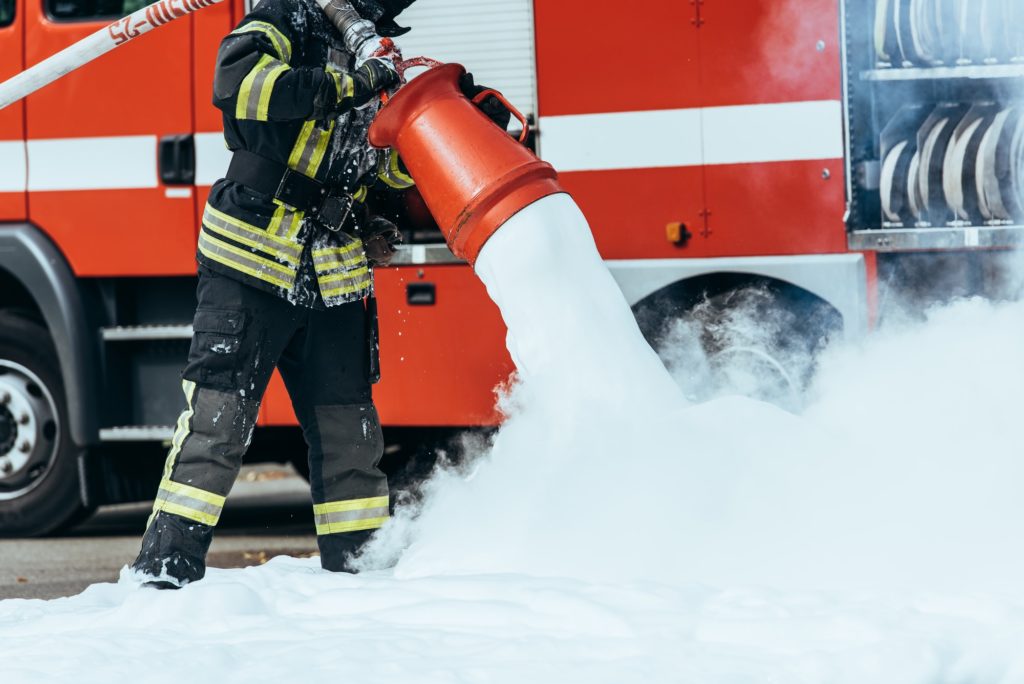
For many years now, foam has been used as a key fire fighting medium for putting out combustible liquids. Unlike other fire suppression agents like water and CO2, foam extinguishes liquid fires in three phases; cooling off the flames, separating the fuel source from the surfaces and smothering. Besides, it can also properly cushion the fuel sources and surfaces from re-igniting the fire.
Foam is considered the primary fire suppression agent for ensuring better fire protection in areas where flammable liquids are processed, distributed or stored. The most common applications of fire fighting foam include aircraft hangers, oil and gas processing plants, oil storage warehouses, commercial cooking areas, loading platforms and other industrial spaces. Foam fire suppression is effective both indoors and outdoors, making it quite versatile.
What is Fire Fighting Foam?
The foam that is used in fire fighting is a stable mass comprised of tiny bubbles of air with a lower density than water, gas or oil. The mass is made up of three key ingredients that include foam concentrate, water and air. When mixed in the correct proportions, the ingredients produce a homogeneous blanket called foam. The foam is then, filled into pressurized devices or gas cylinders like fire extinguishers from where they are discharged to extinguish fires during an emergency.
How Fire Fighting Foam Works
The process of combustion or burning is supported by three elements that include fuel, heat and oxygen. Under normal circumstances, the removal of or interference with any of these elements can stop the fire. Although fire fighting foam does not interfere with the process of combustion, it also works in the same context.
Foam works in the stages and the first one involves creating a blanket over the fuel source to smother the flames. It then, separates the fuel source from the surface on fire. The third step is cooling off the fuel source and surfaces. Finally, the foam sucks off any remaining vapours on the surfaces to prevent the fire from re-ignition.
Fire fighting foam is effective on both hydrocarbon fuels and polar solvent or alcohol fuels. Hydrocarbon fuels do not mix with water and include gasoline, jet fuel, kerosene and diesel. Solvent fuels are mixable in water and include alcohol-based combustible liquids.
Common Types of Fire Fighting Foam Concentrates
There are various kinds of foam concentrates used in fire fighting systems. The most common ones today include.
- Aqueous Film Forming Foam (AFFF)
- Alcohol Resistant (AR-AFFF)
- Synthetic Foam (Medium or High Expansion detergents)
- Wetting Agent
- Class ‘A’ Foam
- Protein
- Film Forming Fluoroprotein (FFFP)
- Fluoroprotein
While all the above types of fire fighting foam concentrates can effectively put out most flammable liquid fires, some are specific to certain combustible liquid fuel sources. For instance, AR-AFFF can extinguish fires caused by hydrocarbons faster than those started by flammable solvents. The particular type of fire fighting foam concentrate to choose will mainly depend on the potential fire risks on your building and the nature of the environment where it will be used.
The long term effectiveness of fire fighting foam concentrate is based upon exposure to temperature, how it is stored, dilution, exposure to air and contamination. If kept under proper conditions in the original package, foam concentrates can retain their fire fighting capabilities for a period of up to ten years or more. Depending on the storage container, foam fire extinguishers can be easily refilled or recycled after the contents are depleted.
Benefits of Fire Fighting Foam
Fire fighting foam is swiftly gaining popularity over most fire suppression agents today. The following are some of the unique advantages of fire fighting foam.
Safely extinguishes flammable liquids fires fast
Foam concentrates are the best suppression agent for fires resulting from combustible liquids like gasoline, kerosene, diesel and other oils. Foam effectively cools off the heat, smothers the flames and sucks off vapours from the surfaces, thereby putting out class ‘A’ and ‘B’ fires quickly and safely.
Conserves water and energy
Foam concentrates are the key ingredient in fire fighting foam, which requires just a little water. Besides, discharging the fire suppression agent from the storage devices does not require a significant amount of energy. All these not only make fire fighting foam more efficient but, also very economical.
Less water damage
Unlike fire sprinklers or water-based fire extinguishers, fire fighting foam uses very little amounts of water. As a result, using a foam fire suppression system during fire emergencies will not cause any significant water damage to your documents and equipment in the building.
HDB Registered Contractor
License Number: HB-09-5474D
